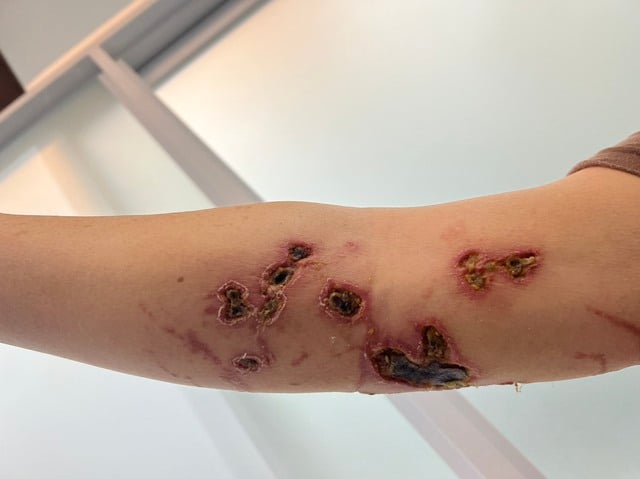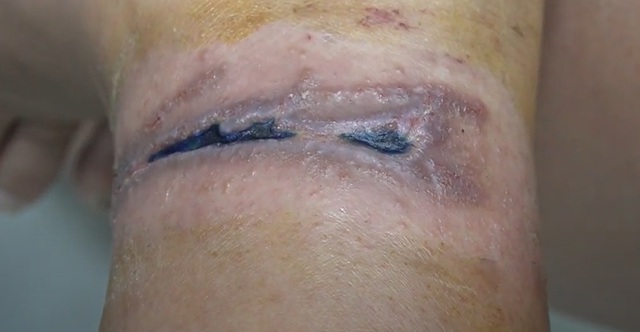The patient said that a few days ago, he went swimming in Vung Tau and was stung by a jellyfish on his leg. After coming ashore, the skin on the patient's left leg was swollen, the lines along the sting turned red, blistered and had blisters.
Similarly, a female patient (55 years old, residing in Phan Thiet, Binh Thuan ) came to the clinic with many areas of skin on her right arm with allergic contact dermatitis, erythematous patches, swelling with ulcers, pus and necrosis. The patient shared that a few days before, she went swimming in the sea and was "attacked" by a jellyfish.
On July 24, Master - Doctor Pham Thi Uyen Nhi, Deputy Head of the General Planning Department, Ho Chi Minh City Dermatology Hospital, said that since the beginning of summer, the hospital has continuously received many cases of patients with dermatitis due to contact with jellyfish.
In cases where patients come early, doctors promptly treat them with specific oral and topical medications to help quickly recover from dermatitis. However, there are also cases where patients self-treat, which can lead to complications such as infection, discharge, skin ulcers or widespread lesions that are more difficult to treat. In some cases, systemic medications such as antibiotics and strong anti-inflammatory drugs must be used to control the condition.

A case of contact dermatitis caused by jellyfish
BSCC
Symptoms of jellyfish stings
According to Dr. Uyen Nhi, fire jellyfish is a dangerous jellyfish that can cause irritation and allergies on human skin. When stung by a fire jellyfish, the patient may have the following symptoms:
Stinging pain: A sharp, stabbing pain, like being stabbed or whipped by a needle, often occurs immediately after contact with a jellyfish tentacle.
Rash: The area of skin stung by a jellyfish will quickly become red, swollen, and may spread to surrounding areas.
Itching and burning: The exposed skin area becomes itchy and sore and can last for hours or even days.
Systemic symptoms: in severe cases, patients may experience systemic symptoms such as nausea and vomiting, difficulty breathing, increased heart rate...
How to give first aid when stung by a jellyfish?
- Wash the skin area that came into contact with the jellyfish. Wash the wound with clean water or saline solution.
- Use tweezers or wear gloves to carefully remove any jellyfish tentacles that are still attached to the skin. Do not use your bare hands as they may get stuck with jellyfish venom and spread the infection to the affected skin.
- Apply a cold compress. Apply a cold washcloth or ice pack to the injury for 20 minutes to reduce pain and swelling. Avoid applying ice directly to the skin as this can cause frostbite.
- Visit facilities with dermatology clinics or dermatologists for timely treatment to avoid unwanted complications.
- Monitor for other signs, if there are systemic signs, go to the hospital immediately for treatment and monitoring.
- Note, do not self-treat with folk methods, apply leaves, or apply unknown medicine because it can cause the condition to worsen, the damage to spread, or infection in the area of skin stung by jellyfish.

Jellyfish stings on the legs
BSCC
How to monitor people stung by jellyfish?
According to Dr. Uyen Nhi, jellyfish contain a lot of venom that can cause symptoms such as burning, swelling, redness, itching, even skin ulcers and necrosis if not treated promptly. Monitoring people who have been stung by jellyfish is extremely important to detect dangerous complications early and have timely treatment measures.
Monitor for signs such as pain, rash, itching and burning of the skin. If these symptoms become more and more severe, the affected area spreads, there is a lot of discharge, or the patient has nausea, vomiting, difficulty breathing, increased heart rate, etc., go to a medical facility for timely examination and treatment.
It is extremely important to monitor people stung by jellyfish, and patients should not be treated on their own.
Complications that can occur when being stung by jellyfish such as: skin ulcers, post-inflammatory hyperpigmentation, post-inflammatory depigmentation, bad scars, hypertrophic scars, keloid scars in the area of skin stung by jellyfish can be limited if handled and treated promptly.
Doctor's advice on measures to prevent jellyfish stings when going to the beach
Doctor Uyen Nhi recommends some measures to prevent jellyfish stings when going to the beach:
1. Avoid swimming or participating in water activities in areas with jellyfish: Check the jellyfish forecast before going to the beach. Follow the instructions of lifeguards or locals about jellyfish risks.
2. Wear protective clothing when swimming. Wear long-sleeved swimsuits, long pants, and socks when swimming to protect your skin from the sting of fire jellyfish. Use a wide-brimmed hat to protect your face and neck.
3. Know how to give first aid when stung by a jellyfish: clean the wound, remove the jellyfish tentacles, apply cold compresses, monitor the signs and go to a medical facility when symptoms worsen.
Source: https://thanhnien.vn/tphcm-nhieu-nguoi-bi-noi-hong-ban-sung-ne-da-do-tiep-xuc-sua-bien-185240724125118803.htm

































































































Comment (0)